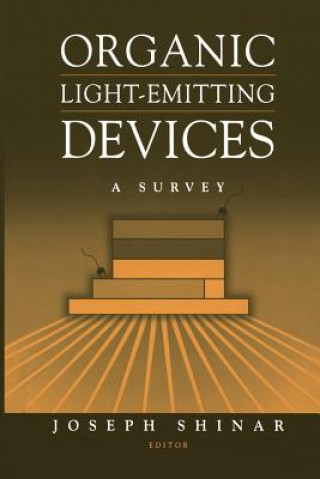
Kód: 01421687
Organic Light-Emitting Devices
Autor Joseph Shinar
Although it has long been possible to make organic materials emit light, it has only recently become possible to do so at the level and with the efficiency and control necessary to make the materials a useful basis for illuminatio ... celý popis
- Jazyk:
 Angličtina
Angličtina - Vazba: Brožovaná
- Počet stran: 309
Nakladatelství: Springer-Verlag New York Inc., 2011
- Více informací o knize

Mohlo by se vám také líbit
-

Saving Biological Diversity
4798 Kč -

Taxation and Public Finance in Transition and Developing Economies
6578 Kč -

Statistics in Criminal Justice
2720 Kč -

Piezoelectric and Acoustic Materials for Transducer Applications
5094 Kč -

Linking Trade and Security
3313 Kč -

Optical Solitons
5094 Kč -

GESCHIEDENIS DER FRANSCHE PROTESTANTSCHE
620 Kč -

Derek Jarman's Medieval Modern
762 Kč -

Nostalgic Large Print Word Search: The 1960s
434 Kč -

Office Holders In The Duchy Of Lancaster
645 Kč -

Selected Poems and Prose of Paul Celan
723 Kč -
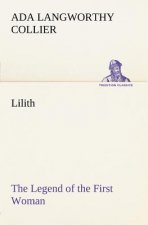
Lilith The Legend of the First Woman
350 Kč -

In the Fog
609 Kč -

Natural Product Synthesis II
9842 Kč
Darujte tuto knihu ještě dnes
- Objednejte knihu a zvolte Zaslat jako dárek.
- Obratem obdržíte darovací poukaz na knihu, který můžete ihned předat obdarovanému.
- Knihu zašleme na adresu obdarovaného, o nic se nestaráte.
Více informací o knize Organic Light-Emitting Devices
Nákupem získáte 336 bodů
 Anotace knihy
Anotace knihy
Although it has long been possible to make organic materials emit light, it has only recently become possible to do so at the level and with the efficiency and control necessary to make the materials a useful basis for illumination or displays. The early electroluminescent devices provided reasonably bright light, but required high operating voltages, produced only a narrow range of colors, and had severely limited lifetimes. Recent developments, however, make it possible to manufacture organic light-emitting devices that are thin, bright, efficient, and stable and that produce a broad range of colors.§This book surveys the current status of the field. It begins with an overview of the physics and chemistry of organic light emitting devices by J. Shinar and V. Savvateev. Subsequenbt chapters discuss the design of molecular materials for high performance devices (C. Adachi and T. Tsutsui) and chemical degradation and physical aging (K. Higginson, D. L. Thomsen, B. Yang, and F. Papadimitrakopoulos). A. Dodabalapur describes microcavity OLEDs, and Y. Shi, J. Liu, and Y. Yang discuss polymer morphology and device performance. Various aspects of devices based on polyparaphenylene vinylenes are discussed in chapters by N.C. Greenham and R.H. Friend and by H. Chayet, V. Savvateeyv, D. Davidov and R. Neumann. Chapters by S. Tasch, W. Graupner, and G. Leising and by Y. Z. Wang, D. Gebler, and A. J. Epstein describe OLEDs based on poly(paraphenylene) and poly(pyridine), respectively. The book concludes with a chapter on polyfluorene-based devices, which show great promise for producing light in all colors from blue to red.Although it has long been possible to make organic materials emit light, it has only recently become possible to do so at the level and with the efficiency and control necessary to make the materials a useful basis for illumination in any but the most specialized uses. This book surveys the current status of the field.Although it has long been possible to make organic materials emit light, it has only recently become possible to do so at the level and with the efficiency and control necessary to make the materials a useful basis for illumination in any but the most specialized uses. The early electroluminescent panels and cells provided reasonably bright light, but required high operating voltages, produced only a narrow range of colors, and had severely limited lifetimes. Recent developments, however, make it possible to manufacture organic light-emitting devices that are thin, bright, efficient, and stable and that produce a broad range of colors.§This book surveys the current status of the field. It begins with an overview of the physics and chemistry of organic light emitting devices by J. Shinar and V. Savvateev. It then turns to the design of molecular materials for high performance devices (C. Adachi and T. Tsutsui) and a discussion of chemical degradation and physical aging (K. Higginson, D.L. Thomsen, B. Yang, and F. Papadimitrakopoulos). A. Dodabalanpur describes microcavity LEDs, and Y. Shi, J. Liu, and Y. Yang discuss polymer morphology and device performance. Various aspects of devices based on polyparaphenylenes are discussed in chapters by N.C. Greenham and R.H. Friend; by Chayet, Savvateeyv, Davidoff and Neumann; and by S. Tasch, W. Graupner, and G. Leising. The book concludes with a discussion of devices based on pyridine-containing conjugated polymers by Y.Z. Wang, D. Gebler, and A.J. Epstein
 Parametry knihy
Parametry knihy
Zařazení knihy Knihy v angličtině Technology, engineering, agriculture Electronics & communications engineering Electronics engineering
3362 Kč
- Plný název: Organic Light-Emitting Devices
- Podnázev: A Survey
- Autor: Joseph Shinar
- Jazyk:
 Angličtina
Angličtina - Vazba: Brožovaná
- Počet stran: 309
- EAN: 9781441929600
- ISBN: 1441929606
- ID: 01421687
- Nakladatelství: Springer-Verlag New York Inc.
- Hmotnost: 499 g
- Rozměry: 235 × 155 × 23 mm
- Datum vydání: 09. October 2011
Oblíbené z jiného soudku
-
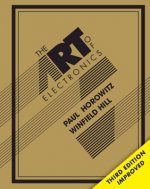
The Art of Electronics
2543 Kč -

Practical Electronics for Inventors
970 Kč -
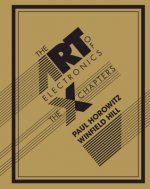
The Art of Electronics: The x Chapters
1651 Kč -

How to Diagnose and Fix Everything Electronic, Second Edition
603 Kč -
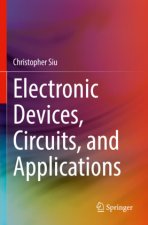
Electronic Devices, Circuits, and Applications
1732 Kč -

Practical Electronics - A Self-Teaching Guide
567 Kč -

Practical Electronics: A Complete Introduction
437 Kč -

Lego Power Functions Idea Book, Volume 1
579 Kč -

Design of Analog CMOS Integrated Circuits
1919 Kč -

Automotive Oscilloscopes
1355 Kč -

Signals & Systems For Dummies
492 Kč -

LOGO! 8 - A Practical Introduction, with Circuit Solutions and Example Programs
682 Kč -

LEGO MINDSTORMS EV3 Idea Book
589 Kč -

Encyclopedia of Electronic Components Volume 2
595 Kč -

Probabilistic Robotics
2920 Kč -

Motors for Makers
779 Kč -

Schaum's Outline of Electronic Devices and Circuits, Second Edition
598 Kč -

High-Frequency Magnetic Components 2e
4751 Kč -

Theory of Robot Control
4204 Kč -

Introduction to Optimal Control Theory
2422 Kč -

Art of Hardware Architecture
3362 Kč -

FPGA Design
3089 Kč -

Computer Arithmetic
2866 Kč -

Schaum's Outline of Digital Principles
849 Kč -

Designing with Xilinx (R) FPGAs
3682 Kč -

The LEGO Power Functions Idea Book, Vol. 2
545 Kč -

Complete Electronics Self-Teaching Guide with Projects
702 Kč -

Audiophile Vacuum Tube Amplifiers - Design, Construction, Testing, Repairing & Upgrading, Volume 1
1741 Kč -

Audiophile Vacuum Tube Amplifiers - Design, Construction, Testing, Repairing & Upgrading, Volume 2
1740 Kč -

Audiophile Vacuum Tube Amplifiers Volume 3
1740 Kč -

Lego Technic Idea Book: Simple Machines
455 Kč -

Arduino Cookbook
1046 Kč -

How to Diagnose and Repair Automotive Electrical Systems
574 Kč -

Electronics For Dummies, UK Edition
712 Kč -
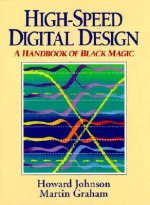
High Speed Digital Design
2465 Kč -

Automobile Electrical and Electronic Systems
1578 Kč -

Scary Smart
611 Kč -

3,000 Solved Problems in Electrical Circuits
990 Kč -

Robotics, Vision and Control
1772 Kč -

Lego Technic Idea Book: Fantastic Contraptions
447 Kč -

Lego Technic Idea Book: Wheeled Wonders
452 Kč -

Cybernetics
378 Kč -
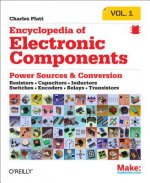
Encyclopedia of Electronic Components
500 Kč -

PLC Controls with Structured Text (ST)
751 Kč -

Make: More Electronics
689 Kč -

Fundamentals of Power Electronics
2572 Kč -
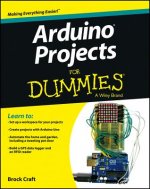
Arduino Projects For Dummies
520 Kč -

C Programming on Raspberry Pi
871 Kč -

Manga Guide To Microprocessors
581 Kč
Osobní odběr Praha, Brno a 12903 dalších
Copyright ©2008-24 nejlevnejsi-knihy.cz Všechna práva vyhrazenaSoukromíCookies



 Vrácení do měsíce
Vrácení do měsíce 571 999 099 (8-15.30h)
571 999 099 (8-15.30h)